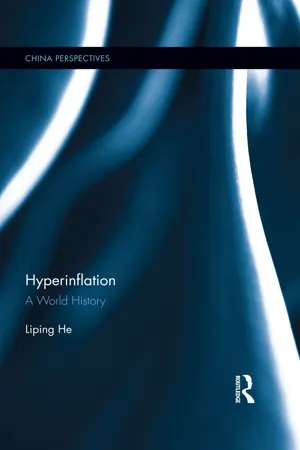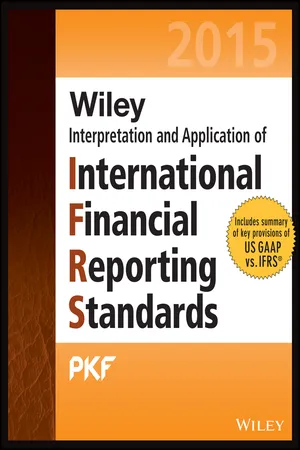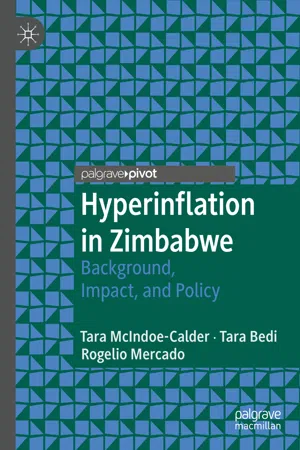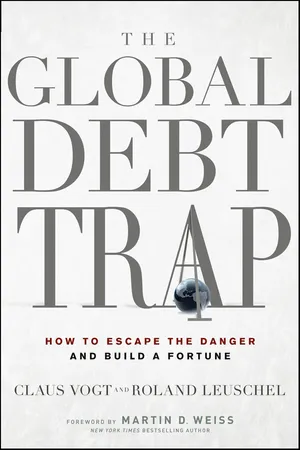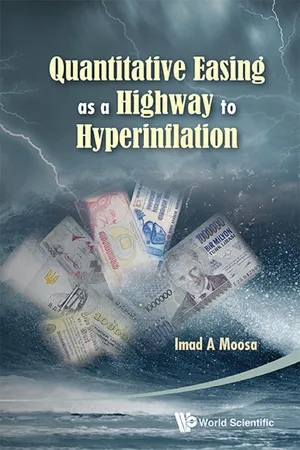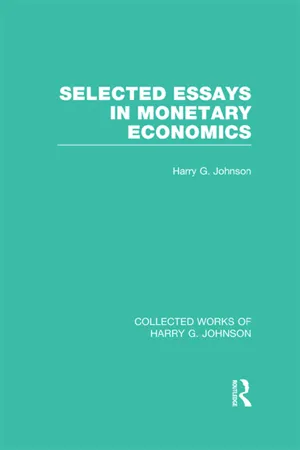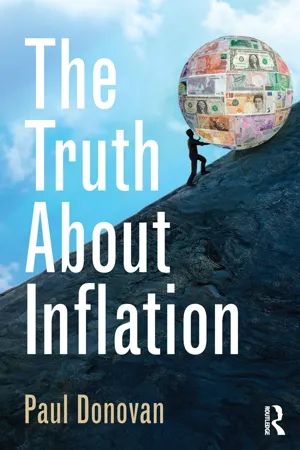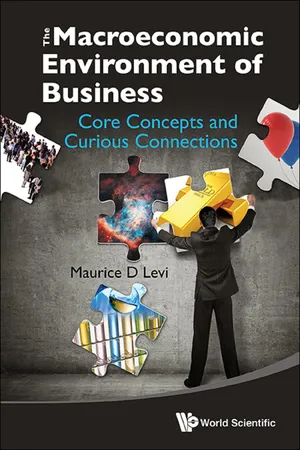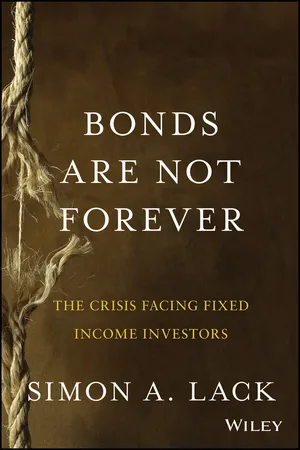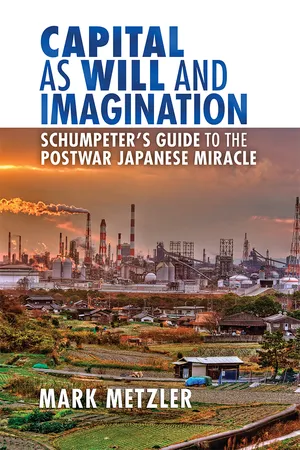Economics
Hyperinflation
Hyperinflation refers to an extremely rapid and out-of-control increase in the general price level of goods and services within an economy. This phenomenon typically occurs when the supply of money in circulation grows significantly faster than the available goods and services. Hyperinflation can lead to a loss of confidence in the currency, severe economic instability, and a sharp decline in the purchasing power of money.
Written by Perlego with AI-assistance
Related key terms
12 Key excerpts on "Hyperinflation"
- eBook - ePub
Hyperinflation
A World History
- He Liping(Author)
- 2017(Publication Date)
- Routledge(Publisher)
Introduction Basic concepts of Hyperinflation“Natura non facit saltum .” (Nature does nothing in jumps)An axiom cited by Alfred Marshall in his Principles of Economics , 1890“Nature abhors a vacuum.” AristotleInflation as an economic and monetary phenomenon usually refers to a rising trend in general prices in a country over a period of time. Hyperinflation is an unusual type of inflation wherein general price rises reach such unusually high levels that the currency tends to become no longer able to perform its normal functions in part or wholly. Monetary conditions in the economy have therefore rapidly become enormously aberrant. The causes of Hyperinflation may be easily confused with those of inflation, but they are distinctively different. As a type of financial crisis, Hyperinflation can lead to economic collapse, and a stabilization program is necessary following an outbreak of Hyperinflation. Correcting policy, building institutions in sensible ways, and having access to international resources are the most important elements of a successful stabilization program.What is Hyperinflation?
Inflation has been common worldwide from past to present, but Hyperinflation has not. Over the course of history, the known incidence of Hyperinflation is not high. From the late eighteenth century to the 2000s, 56 episodes of Hyperinflation involving nearly 40 countries or political regimes have been recorded, based on a “monthly” definition of Hyperinflation,1 and 16 countries have witnessed at least one Hyperinflationary incidence between 1800 and 2008,2 according to an “annual” definition of Hyperinflation.Three quantitative criteria of Hyperinflation
The first quantitative definition of Hyperinflation is that a general price level increases 50 percent or more from one month to the next. And, the second is that a general price level climbs at least 500 percent year on year. The two definitions of Hyperinflation are not directly comparable; there is no way to say which is greater. Of course, in a year when the monthly inflation rate is 50 percent every month, the annual inflation rate will be nearly 13,000 percent – corresponding to an almost 130-fold increase in prices – far greater than the annual criterion of 500 percent. In reality, however, hardly any country would see such an inflation rate sustained over a long period. In other words, an economy experiencing a monthly rate of 50 percent for one month or a few months may end up with an annual rate below 500 percent for the year. Or, an annual rate of 500 percent may be accompanied by a monthly rate of at least 50 percent for one or more months during that year. - eBook - ePub
Wiley IFRS 2015
Interpretation and Application of International Financial Reporting Standards
- (Author)
- 2015(Publication Date)
- Wiley(Publisher)
Hyperinflation is a condition that is difficult to define precisely, as there is not a clear demarcation between merely rampant inflation and true Hyperinflation. However, in any given economic system, when the general population has lost faith in the stability of the local economy, that business transactions are commonly either denominated in a stable reference currency of another country, or are structured to incorporate an indexing feature intended to compensate for the distortive effects of inflation, this condition may be present. As a benchmark, when cumulative inflation over three years approaches or exceeds 100%, it must be conceded that the economy is suffering from Hyperinflation.Hyperinflation is obviously a major problem for any economy, as it creates severe distortions and, left unaddressed, results in uncontrolled acceleration of the rate of price changes, ending in inevitable collapse as was witnessed in post-World War I Germany. From a financial reporting perspective, there are also major problems, since even over a brief interval such as a year or even a quarter, the statement of comprehensive income will contain transactions with such a variety of purchasing power units that aggregation becomes meaningless, as would adding dollars, francs, and marks. This is precisely the problem discussed earlier in this chapter, but raised to an exponential level.In a truly Hyperinflationary economy, users of financial statements are unable to make meaningful use of such statements unless they have been recast into currency units having purchasing power defined by prices at or near the date of the statements. Unless this common denominator is employed, the financial statements are too difficult to interpret for purposes of making management, investing, and credit decisions. Although some sophisticated users, particularly in those countries where Hyperinflation has been endemic, such as some of the South American nations, including Brazil and Argentina, and for certain periods nations such as Israel, are able to apply rules of thumb to cope with this problem, in general modifications must be made to general-purpose financial statements if they are to have any value. - eBook - ePub
Hyperinflation in Zimbabwe
Background, Impact, and Policy
- Tara McIndoe-Calder, Tara Bedi, Rogelio Mercado(Authors)
- 2019(Publication Date)
- Palgrave Pivot(Publisher)
© The Author(s) 2019 T. McIndoe-Calder et al. Hyperinflation in Zimbabwe https://doi.org/10.1007/978-3-030-31015-8_4Begin Abstract4. Economics of Hyperinflation
Tara McIndoe-Calder1,Tara Bedi2andRogelio Mercado3(1) Central Bank of Ireland, Dublin, Ireland(2) Economics Department, Trinity College Dublin, Dublin, Ireland(3) The South East Asian Central Banks Research and Training Centre, Kuala Lumpur, MalaysiaAbstract
This chapter provides an overview of the conceptual and theoretical motivation behind the origins, mechanics and resolution of Hyperinflations. It relates various economic models into a framework that can be used to understand Hyperinflations. Finally, this chapter highlights the importance of inflationary expectations and seigniorage in the Hyperinflation process.End AbstractKeywords
Hyperinflation Money supply Money demand Adaptive expectations Rational expectations SeigniorageIntroduction
As stated in previous chapters, Hyperinflation describes a situation where the price level of goods and services increases very rapidly. As defined by Cagan (1956 ), Hyperinflation begins in the month where the increase in price levels exceeds 50 per cent a month and ends in the month before the monthly increase drops below 50 per cent. Empirically, there are episodes where inflation is thought to be very high, but not high or disruptive enough to be classified as Hyperinflations. Vegh (1992 ) terms these episodes “chronic inflation ”, where inflation is higher than in periods of moderate inflation, but much lower than in Hyperinflations. Moreover, chronic inflation tends to be more persistent, whereas Hyperinflations are rare occurrences. Hence, although Cagan’s (1956 ) definition of Hyperinflation is arbitrary, at 50 per cent, there is a clear demarcation between when inflation is chronic and when it becomes extremely severe. Hyperinflation differs from chronic inflation - eBook - ePub
The Global Debt Trap
How to Escape the Danger and Build a Fortune
- Claus Vogt, Roland Leuschel, Martin D. Weiss(Authors)
- 2010(Publication Date)
- Wiley(Publisher)
CHAPTER 4 The Road to (Hyper)InflationWill the bursting of the real estate bubble lead to a deflationary endgame? Or will the printers of money with their so-called rescue packages and unaffordable economic stimulus programs prevail, producing rampant inflation? That is the decisive question for investment success over the coming years. So it behooves you to become familiar with the arguments behind both scenarios, and this, in turn, is not possible without clearly defining the terms.Today, the terms inflation and deflation are generally used to refer to a rise or decline in price levels measured by a basket of consumer goods. Although technically accurate, the problem with this definition should be clear: it describes only one of many symptoms—namely price changes in a basket of goods that can be manipulated at will. However, the underlying cause of these price changes remains—intentionally—unclear. Plus, the composition of the consumer basket, along with the methods for measuring their price changes, leave an extremely broad latitude for generating politically desired results.In contrast, the classic definition of the terms inflation and deflation, which has now largely fallen into disuse, begins not with the symptoms but with the cause. Inflation (deflation) is an increase (decrease) in the supply of money and credit .Let’s first explore the latter. The Deflationary ScenarioThe direct consequence of speculative bubbles that burst is, of course, none other than a price collapse in the object of that speculation. If these are contained in the consumer basket, and if they cheapen the basket overall, then economists who base their definition on consumer prices will speak of deflation.Bursting speculative bubbles also are deflationary in classical definition: they lead to an increase in the demand for cash and a decrease in the supply of money and credit. Cash and equivalent—including cash in circulation, federal funds, money market funds, and other short-term instruments—are viewed as havens in times of great uncertainty in the financial markets, and they are thus in greater demand. - Imad A Moosa(Author)
- 2013(Publication Date)
- WSPC(Publisher)
Hyperinflation represents a traumatic experience that produces worthlessness. With reference to the German Hyperinflation, Ferguson (2008) points out that “not only was money rendered worthless; so too were all the forms of wealth and income fixed in terms of that money”. This makes one wonder why any rational government would engage in actions that cause or sustain Hyperinflation. One reason for such actions is that often the alternative to Hyperinflation is either a depression or a military defeat. Countries that go through this experience will in the aftermath enact policies to prevent its recurrence. This often means making the central bank very aggressive in accomplishing the objective of maintaining price stability, as was the case with the German Bundesbank, or adopting a currency board.The consequences of Hyperinflation are severe forms of the consequences of moderate inflation — all of those that were examined in Chapter 5 . We have seen, for example, that inflation causes an arbitrary redistribution of income from creditors to debtors. Therefore, a company with uncollected receivables will be put in a disadvantage, losing more and more the longer the receivables remain uncollected. In Fig. 6.10 , we see what happens to the value of receivables initially worth $100,000 at monthly inflation rates of 1% (moderate inflation) and 20% (Hyperinflation). The value of the receivables declines much more rapidly under Hyperinflation.Fig. 6.10.Erosion of receivables under inflation (simulated data).Hyperinflation is bad, actually destructive, for business planning (and hence, economic activity) — it is even bad for financial reporting. For example, the generally accepted accounting principles (GAAP) are poorly adapted to describe economic reality for firms operating under Hyperinflationary conditions. Traditional reporting systems produce large foreign exchange gains or losses that are difficult to interpret, mismatch revenues and expenses and overstate interest income and expenses. Under these conditions, financial statement users are provided with unreliable information for the evaluation of a business. Choi and Gunn (1997) propose a transaction-based reporting model to overcome many of these deficiencies. The model involves an examination of reported numbers in a disaggregated fashion, showing that with little additional effort conventional accounting data can be transformed into information that can be useful to a range of financial statement users. Whittington et al.- Harry Johnson(Author)
- 2013(Publication Date)
- Routledge(Publisher)
1 (ii) Does inflation necessarily lead to monetary collapse?The answer is no, provided that the price system is uncontrolled and prices are allowed to rise freely. The strongest evidence on this point comes from the Chinese postwar Hyperinflation, during which money continued to circulate despite the extremely rapid rise in prices.2 Cagan’s evidence suggests the same conclusion. Where monetary breakdowns do occur is where rapid inflation is combined with general price control, so that money ceases to be usable for making transactions because the nominal value fixed by price controls comes to be far above the real value determined by the plethora of money and the shortage of goods. This is the explanation, for example, of the breakdown of the German currency after World War II and the adoption of the use of cigarettes as a medium of exchange. If prices are free to rise money remains usable because its real value is adjusted to the inflation.(iii) Does inflation redistribute income away from the savers, the middle class, etc., on a socially intolerable scale?The answer again is no. Most of the evidence we have on mild inflations indicates that it is difficult to detect such large-scale redistributions of income over any substantial period.1 Over a short period, when an inflation has occurred that was not expected (as typically happens in war), there may be substantial redistribution of income and wealth away from those groups that have made their occupational choices and their savings and investment decisions in the expectation of the continuance of stable prices. But in the longer run, when the expectation of inflation becomes built into the economy’s behaviour patterns, the nominal reward for saving (money interest rates) comes to contain an allowance for expected future inflation, and employment contracts and wage and salary relativities are readjusted to conform with the underlying demand and supply situation. For example, school and college teachers in the United States were for a long time sufferers from inflation; but their salaries have now been for the most part adjusted to the growing scarcity of teachers. It can be argued on the contrary that once inflation has come to be expected, it is the termination of inflation by monetary restriction that will cause socially intolerable redistributions of income and wealth, because borrowers who borrowed at high interest rates on the expectation that rising prices would make the real interest rate substantially less than the nominal interest rate will then find themselves obliged to pay higher real rates of interest than they had counted on. (This was one of Keynes’ main arguments against Britain’s return to the gold standard at the old parity after World War I.)2- Peter J. Tanous, Jeff Cox(Authors)
- 2011(Publication Date)
- Wiley(Publisher)
The lesson of Diocletian holds significance today in part because it provides a philosophical warning on overreaching government programs while vividly displaying the practical dangers of trying to devalue your way out of a crisis. Diocletian wasn’t stupid, nor are today’s policy makers who think there won’t be a price to pay when the bill comes due for all those dollars out there in circulation. President Barack Obama and Federal Reserve Chairman Ben Bernanke are both smart men who believe extreme circumstances necessitated extreme measures. Timothy Geithner and his predecessor, Henry Paulson, both recognized the dangers of devaluation, but made reasoned and considered decisions to take that risk. Even as this book was being written, there was nary an economist to be found talking about inflation. “Deflation is the primary risk” is their mantra, the emerging specter of Nassim Taleb’s Black Swan be damned.Inflation: Is It Bigger Than a Breadbox?This is a good time, then, to consider just what inflation is. If you ask your neighbor to define inflation, he’ll probably talk to you about soaring prices for gasoline, beer, and groceries. And while these are all perfectly valid descriptions of the effects of inflation, they don’t really address the causes . It is well to remember that this is not a case of the chicken or the egg. The causal relation is clear. Inflation happens when too much money chases too few goods, and the result is a rise, sometimes dramatic, in the prices of goods we have to purchase in order to conduct our daily lives.We like to present a definition of inflation from the brilliant economist and philosopher David Hume, who found it “self-evident” that prices and inflation depended entirely on the supply of goods compared to the supply of money. Hume said an increase in the amount of goods means “they become cheaper,” while an increase in money supply means goods “rise in their value.”Hume (1711–1776) saw the danger that excessive money in the economic system posed and studied closely its effects. So if we are to continue our linear thinking through the discipline of epistemology, Hume’s simple observations that the supply of money and the phenomenon of inflation are inextricably linked are essential to the conclusions of this book. Pump so much money into the economy that it outstrips an optimal level of goods, and you get inflation. Simple as that. The cumulative impacts of all the inflationary pressures at hand will be discussed in greater detail in the ensuing chapter, but it is important to keep Hume’s gentle analysis in mind as we take a further trip through the annals of inflation history.- eBook - ePub
- Paul Donovan(Author)
- 2015(Publication Date)
- Routledge(Publisher)
Economic models abound regarding inflation prediction; most of them are relatively dreary, many are far too mathematical in their approach, and few are of any real use to the investor or consumer trying to think about inflation. Instead of presenting a model for forecasting inflation, therefore, this book tries to present a means for understanding inflation. Understanding what inflation is, and what it is not, is something that is increasingly missing from investment decisions. A proper understanding of why inflation cannot and should not be reduced to a simplistic single figure will prevent investors making potentially damaging decisions. It also identifies some of the challenges policymakers face in balancing the competing forces of perception and reality. This opening chapter therefore aims to set out what inflation actually is. Like any good economics student, it is as well to begin by defining the terms that are to be used. Once we have established what the word ‘inflation’ really means, we can get down to the serious business of debunking the myths that surround the idea, and end up by trying to consider inflation in a way that is useful. So what is inflation? At its most crude, inflation is the rate of change in prices. Which immediately raises the question: what is a price? A price represents a standardised and mutually agreed measure of what one person is prepared to receive in exchange for whatever goods or services that they can provide. Nowadays we tend to standardise prices in terms of money (meaning notes and coins, or more likely their virtual, electronic equivalent) but it could be anything. The cow has been a medium of exchange for millennia, perhaps for longer than any other form of physical currency. Sea shells, cigarettes, split lengths of a stick – anything will do, and all in their turn have been major forms of currency (in America, Germany and England, respectively) - eBook - ePub
The Macroeconomic Environment of Business
Core Concepts and Curious Connections
- Maurice D Levi(Author)
- 2014(Publication Date)
- WSPC(Publisher)
CHAPTER 4 INFLATION“If buyers won’t fall for prices, prices must fall for buyers.”Evan EsarKey Concepts: Consumer price index; GDP deflator; difficulties measuring inflation; quantity theory of money; money demand versus money supply; cost-push versus demand-pull inflation; Hyperinflation; inflation as a hidden tax; gains and losses from inflation; importance of inflationary anticipations.UPS AND DOWNS IN INFLATIONAt different times and in different countries inflation has been a matter of major concern, of little or no concern, and of just about every level of concern inbetween. That is, inflation has varied greatly over time within countries, and also differs substantially between countries. For example, in the first few years of the 21st century the rate of inflation in Zimbabwe reached 5,000 trillion, trillion percent per year i.e., 5,000,000,000,000,000,000,000%. Bank notes were issued for 100 trillion dollars, Zimbabwe dollars. That many dollars, if they were U.S. dollars, could have paid off the U.S. national debt; just one bank note of the millions that were printed! Of course, Zimbabwe dollars were worth essentially nothing. Since the 1970s inflation in Brazil went from relatively modest levels in the “double digits,” to approximately 3,000% per year, and back to modest levels. During the same period inflation in Japan and the United States, while low by Brazilian standards, still varied significantly over time, having declined from over 10% in the 1970s to a couple of percent or less by the end of the first decade of the new millennium. Figure 4.1 which describes U.S. inflation history over almost a century—shows that inflation—a rising price level—is far more frequent than deflation—a declining price level—although there have been occasions, such as during the Great Depression, 1929–1933, when prices fell sharply.Fig.4.1. - eBook - ePub
Bonds Are Not Forever
The Crisis Facing Fixed Income Investors
- Simon A. Lack(Author)
- 2013(Publication Date)
- Wiley(Publisher)
CHAPTER 8INFLATION
A Brief History
Inflation is the hidden tax that eats away at the value of money. High inflation distorts decision making in numerous ways, and because it’s less stable than low inflation, it adds uncertainty to most economic decisions about money. Low and stable inflation is uniformly regarded as conducive to economic growth. Since the very beginning of the use of money as a medium of exchange, governments have been aware of the potential for inflation to slowly, or sometimes spectacularly, destroy savings. There exist numerous examples throughout financial history of currency debasement—often, this was to the perceived benefit of the government through a reduced real value of debt owed to private lenders. Eventually, investors demanded adequate compensation for inflation and federal revenues and outlays began to be indexed for inflation. Even so, prior to that, inflation usually hurt just about everybody.Although accurate data are obviously difficult to obtain farther back than three or four centuries, history going back to Roman times contains examples of currency debasement during which coins issued by the government were minted with ever decreasing percentages of the precious metal from which their value was derived. In other cases, older coins would gradually lose weight and metal content through wear and tear; as new coins were issued with a metal content that conformed to the original, they would be hoarded by consumers and not used because of their greater perceived value, reflecting Gresham’s Law (Selgin, 2010) that “bad money chases out good.”In fourth-century B.C. Greece, Dionysius demanded that all his subjects turn over money in circulation to the government on penalty of death. All the one drachma coins collected were thereupon stamped with a two-drachma mark and used for repayment (Reinhart and Rogoff, 2009). Records of the subsequent inflation do not exist, although one can suppose that it was at least 100 percent. - eBook - ePub
Cornell Studies in Money
Schumpeter's Guide to the Postwar Japanese Miracle
- Mark D. Metzler(Author)
- 2013(Publication Date)
- Cornell University Press(Publisher)
Postwar inflation was a worldwide phenomenon. In the defeated countries—Japan, Germany, Italy, Hungary, and Rumania—and in combatant countries experiencing civil war, such as China and Greece, there was near or outright Hyperinflation at the end of the war. There was a worldwide scarcity of goods, and the imbalance between increased money creation and the limited production of goods created inflationary pressures everywhere. Even in the United States, whose industrial and farm production now supplied so many other countries, inflation appeared immediately in November 1946, when most wartime price controls (except for those on rents) were lifted. Japan’s inflation was two or three orders of magnitude less than the inflation in China and other formerly Japanese-occupied territories. Nor did it approach the unimaginable billions reached at the furthest point of the German inflation in 1923. All the same, many commentators did call it a Hyperinflation, and economic decisions of every kind were conditioned by inflationary considerations.Both monetary and supply-side factors drove the inflation. The war itself consumed vast material resources. Stores of physical wealth of all kinds were used up or destroyed. More than two million houses and their contents were burned up in the U.S. bombing attacks. The production of new flows of wealth was severely restricted. On the monetary side it was different. A stock of monetary claims is a “stock” of representations. The bulk of these representations were not touched by the fires, and banking authorities continued to create new claims right through the crisis. The “supply” of claims multiplied, while the fund of resources they could command was radically diminished.Inflation slowed somewhat in 1948, to about 60 percent per year in wholesale prices.25 In 1949, when U.S. fiscal czar Joseph Dodge imposed a deflation policy, black markets began to close—free markets were relegalized—and prices were relatively stabilized. This policy was dubbed the “Dodge Line” by Ōuchi Hyōe, who tended to approve of it, despite the depression it caused. But it is also clear from the price statistics that price stabilization only “began to begin” with the Dodge Line. Full price stabilization happened only with the return of national independence in 1952. And this is still to speak of wholesale prices—people as consumers continued to pay an “inflation tax.”The postwar inflation was much more than an automatic response to war. It was also the result of a distinctive proinflationary and “Keynesian” policy of massive industrial subsidies. This policy was conceived and promoted by finance minister Ishibashi Tanzan, who was an economic liberal and opponent of state controls. Before considering that process, the next chapters introduce some of the people who figure in this story, and then the question of financial capital itself. - eBook - ePub
- Paul Mattick(Author)
- 2017(Publication Date)
- Routledge(Publisher)
Not only does the relationship between wages and profits change, the distribution of the social product generally shifts in favor of capital accumulation. The social layers with fixed incomes, which find it difficult, if not impossible, to adjust to the inflationary trend, must give up more of their income to capital. The savings of the "little man" are eaten up progressively as the value of productive capital rises in pace with inflation. It was this process of creeping inflation which contained the secret of prosperity. The disadvantages of inflation seemed for the time being to be offset by the advantages of economic boom.Although the dependence of capitalist prosperity on capital accumulation is immanent to the system, it is not recognized by bourgeois economic theory. For bourgeois economists inflation is caused by a demand in excess of production, or even by the immoderate claims of the workers, although the very universality of inflation is a patent contradiction of this view; indeed, inflation plagues even countries with extremely low wages, where there is no monopoly of labor and where demand lags far behind supply. Inflation occurs in depressions, where one would expect deflation. The international character of inflation is proof enough that inflation involves more than merely the erratic consequences of high wages in a few countries.Now, however, when inflation and crisis exist side by side in the leading capitalist countries, the contention that inflation is a consequence of full employment and demand outstripping supply is no longer tenable. The only thing left to blame, therefore, is high wages. And despite all the monopolization of labor, or perhaps even because of it, the bourgeoisie still finds rising unemployment a good taskmaster. Wage contracts, often long term, have with a few unimportant exceptions made it impossible to counteract the burden of steeply rising prices or to make up for past omissions through wildcat strikes; all the more reason, therefore, to take advantage of the all-pervasive depression to reap inflationary profits. One must, so one hears in quite a number of trade unions, face the facts: inflation eats away at any wage rise, making continued demands meaningless. What is now necessary to get out of the depression is a responsible wage policy, i.e., capital must be given the chance to regain its lost profitability.6
Index pages curate the most relevant extracts from our library of academic textbooks. They’ve been created using an in-house natural language model (NLM), each adding context and meaning to key research topics.
